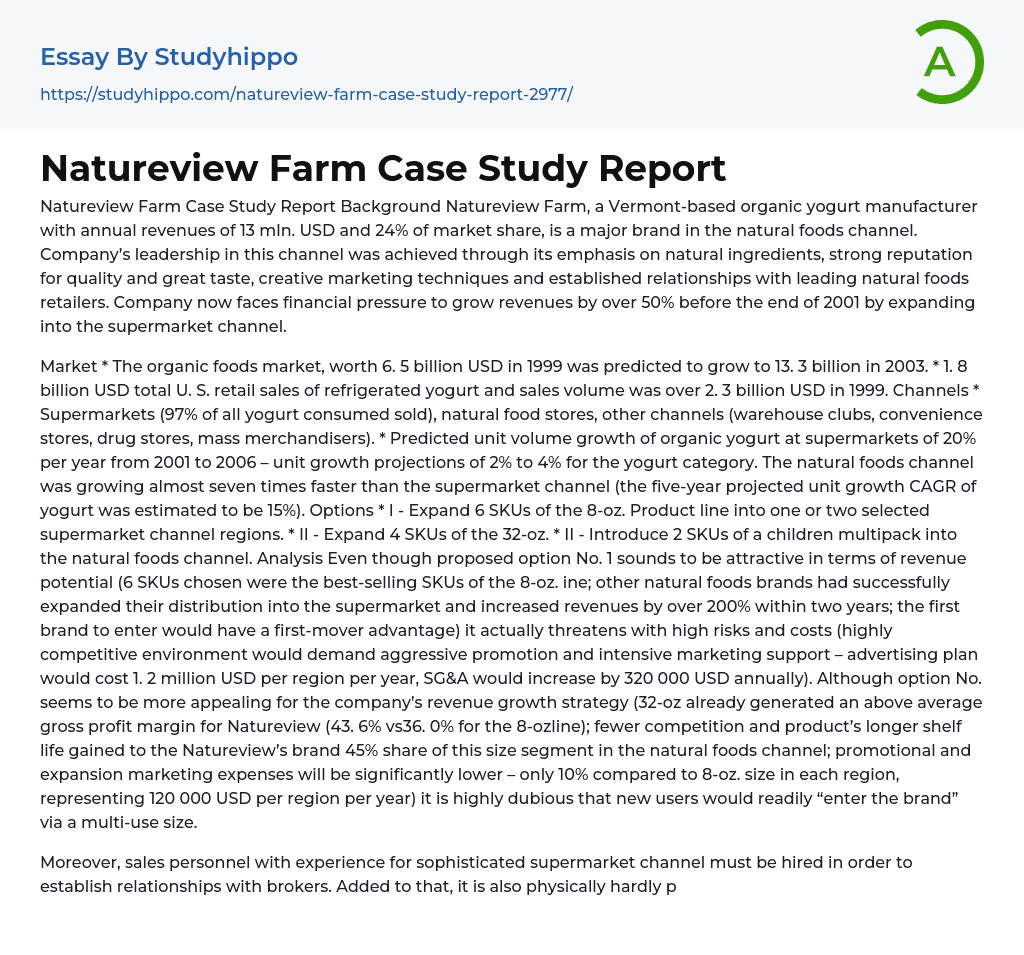Natureview Farm Case Study Report Background Natureview Farm, a Vermont-based organic yogurt manufacturer with annual revenues of 13 mln. USD and 24% of market share, is a major brand in the natural foods channel. Company’s leadership in this channel was achieved through its emphasis on natural ingredients, strong reputation for quality and great taste, creative marketing techniques and established relationships with leading natural foods retailers. Company now faces financial pressure to grow revenues by over 50% before the end of 2001 by expanding into the supermarket channel.
Market * The organic foods market, worth 6. 5 billion USD in 1999 was predicted to grow to 13. 3 billion in 2003. * 1. 8 billion USD total U. S. retail sales of refrigerated yogurt and sales volume was over 2. 3 billion USD in 1999. Ch
...annels * Supermarkets (97% of all yogurt consumed sold), natural food stores, other channels (warehouse clubs, convenience stores, drug stores, mass merchandisers). * Predicted unit volume growth of organic yogurt at supermarkets of 20% per year from 2001 to 2006 – unit growth projections of 2% to 4% for the yogurt category. The natural foods channel was growing almost seven times faster than the supermarket channel (the five-year projected unit growth CAGR of yogurt was estimated to be 15%). Options * I - Expand 6 SKUs of the 8-oz. Product line into one or two selected supermarket channel regions. * II - Expand 4 SKUs of the 32-oz. * II - Introduce 2 SKUs of a children multipack into the natural foods channel. Analysis Even though proposed option No. 1 sounds to be attractive in terms of revenue potential (6 SKUs chosen
were the best-selling SKUs of the 8-oz. ine; other natural foods brands had successfully expanded their distribution into the supermarket and increased revenues by over 200% within two years; the first brand to enter would have a first-mover advantage) it actually threatens with high risks and costs (highly competitive environment would demand aggressive promotion and intensive marketing support – advertising plan would cost 1. 2 million USD per region per year, SG&A would increase by 320 000 USD annually). Although option No. seems to be more appealing for the company’s revenue growth strategy (32-oz already generated an above average gross profit margin for Natureview (43. 6% vs36. 0% for the 8-ozline); fewer competition and product’s longer shelf life gained to the Natureview’s brand 45% share of this size segment in the natural foods channel; promotional and expansion marketing expenses will be significantly lower – only 10% compared to 8-oz. size in each region, representing 120 000 USD per region per year) it is highly dubious that new users would readily “enter the brand” via a multi-use size.
Moreover, sales personnel with experience for sophisticated supermarket channel must be hired in order to establish relationships with brokers. Added to that, it is also physically hardly possible for the sales team to achieve full national distribution in 12 months. Therefore option No. 3 seems to be the best solution as the Natureview Farm will not drastically shift from its carefully established channel strategy as the company doesn’t have enough power and sufficient recourses for that kind of change.
What is more, sales team was confident they could achieve distribution for two SKUs. In addition to that, the natural foods
channel was growing almost seven times faster than the supermarket channel (the five-year projected unit growth CAGR of yogurt was estimated to be 15%). Sales and marketing expenses in this channel is also lower - the cost of complementary cases was estimated at 2. 5% of the product line’s manufacturer sales, and marketing expenses were estimated to be 250 000 USD.
Moreover, financial potential for this option looks quite attractive: projected total revenue for two multipack SKU approximately 10% of the food channel category dollar sales with gross profitability of 37. 6%. It is also important to mention that Natureview would incur no additional SG&A costs to introduce multipack. Thus, this strategy will allow the company to reach their set revenue goal the quickest due to the fact that the annual growth rate of sales of yogurt multi-packs is 12. 5%, versus only 3% for the 6 oz. ize and 2% for 8%. In addition, the profit margins from multi-packs are also significantly higher than those of single servings. Finally, Natureview’s all-natural ingredients would provide the perfect positioning from which to launch its own children’s multi pack product offering into their core sales channel – I strongly believe that expansion into the supermarket channel could potentially influence stable relationships with natural foods channel retailers and negatively affect Natureview’s business success.
- Wal-Mart essays
- Discover essays
- Advertisement essays
- Advertising essays
- Anheuser-busch essays
- Audience Theory essays
- Brand essays
- Brands essays
- Competitor Analysis essays
- Consumer essays
- Detergent essays
- Marketing Management essays
- Marketing Mix essays
- Marketing Plan essays
- Marketing Research essays
- Marketing Strategy essays
- New Product Development essays
- Point Of Sale essays
- Price essays
- Procurement essays
- Product essays
- Product Differentiation essays
- Product Placement essays
- Promotion essays
- Promotion And Marketing Communications essays
- Research Design essays
- Retailing essays
- Trademark essays
- Academia essays
- Academic And Career Goals essays
- Academic Integrity essays
- Brainstorming essays
- Brown V Board of Education essays
- Brown Vs Board Of Education essays
- Coursework essays
- Curriculum essays
- Distance learning essays
- Early Childhood Education essays
- Education System essays
- Educational Goals essays
- First Day of School essays
- Higher Education essays
- Importance Of College Education essays
- Importance of Education essays
- Language Learning essays
- Online Education Vs Traditional Education essays
- Pedagogy essays
- Philosophy of Education essays
- Purpose of Education essays
- Scholarship essays




